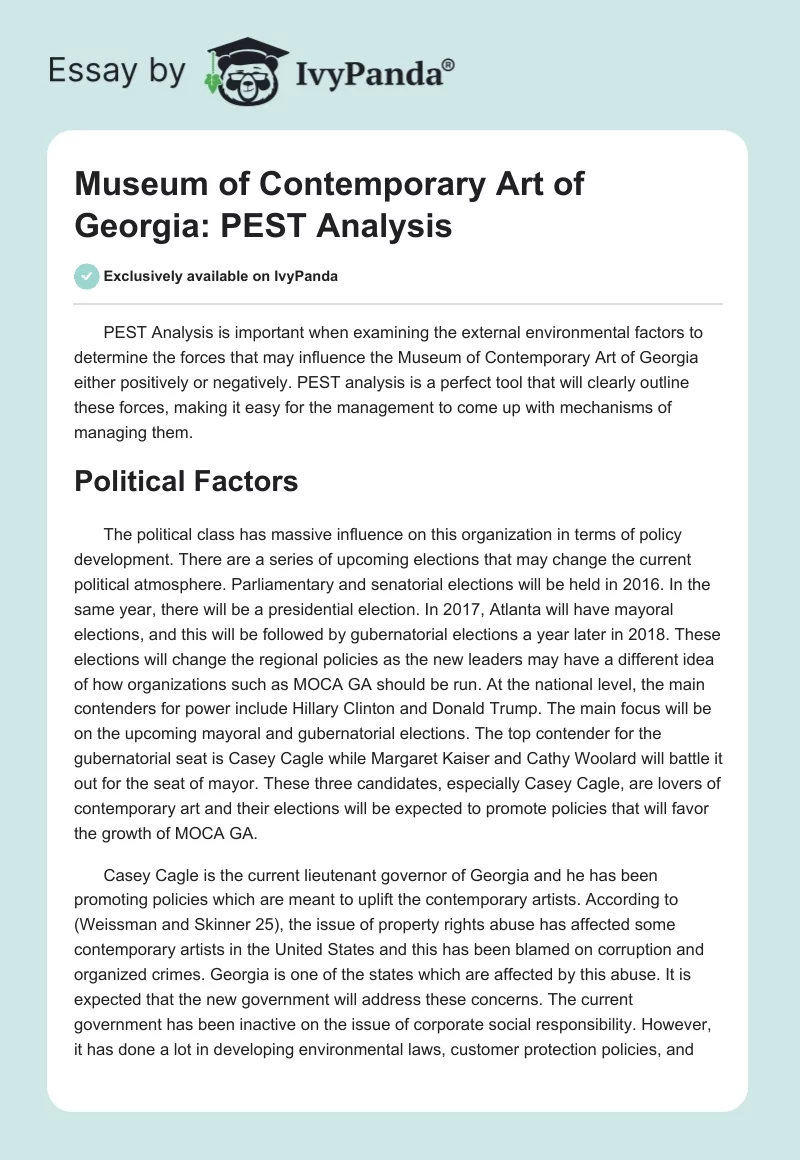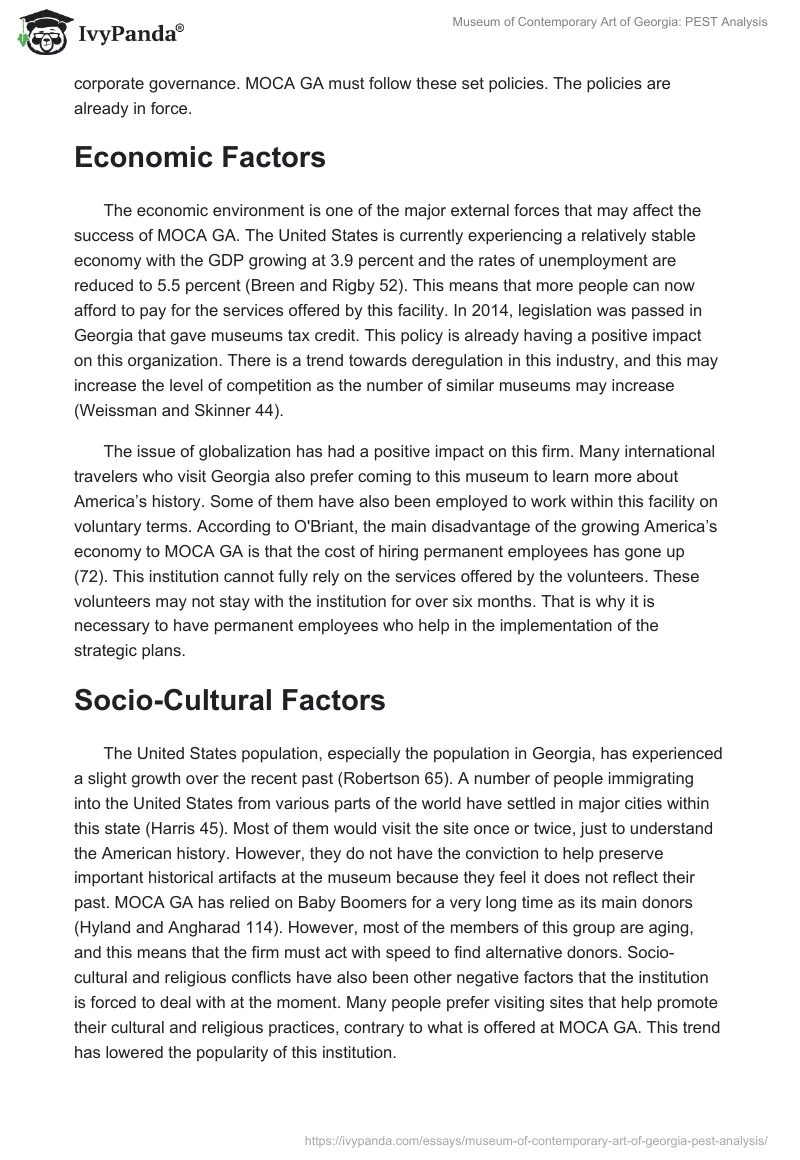PEST Analysis is important when examining the external environmental factors to determine the forces that may influence the Museum of Contemporary Art of Georgia either positively or negatively. PEST analysis is a perfect tool that will clearly outline these forces, making it easy for the management to come up with mechanisms of managing them.
Political Factors
The political class has massive influence on this organization in terms of policy development. There are a series of upcoming elections that may change the current political atmosphere. Parliamentary and senatorial elections will be held in 2016. In the same year, there will be a presidential election. In 2017, Atlanta will have mayoral elections, and this will be followed by gubernatorial elections a year later in 2018. These elections will change the regional policies as the new leaders may have a different idea of how organizations such as MOCA GA should be run. At the national level, the main contenders for power include Hillary Clinton and Donald Trump. The main focus will be on the upcoming mayoral and gubernatorial elections. The top contender for the gubernatorial seat is Casey Cagle while Margaret Kaiser and Cathy Woolard will battle it out for the seat of mayor. These three candidates, especially Casey Cagle, are lovers of contemporary art and their elections will be expected to promote policies that will favor the growth of MOCA GA.
Casey Cagle is the current lieutenant governor of Georgia and he has been promoting policies which are meant to uplift the contemporary artists. According to (Weissman and Skinner 25), the issue of property rights abuse has affected some contemporary artists in the United States and this has been blamed on corruption and organized crimes. Georgia is one of the states which are affected by this abuse. It is expected that the new government will address these concerns. The current government has been inactive on the issue of corporate social responsibility. However, it has done a lot in developing environmental laws, customer protection policies, and corporate governance. MOCA GA must follow these set policies. The policies are already in force.
Economic Factors
The economic environment is one of the major external forces that may affect the success of MOCA GA. The United States is currently experiencing a relatively stable economy with the GDP growing at 3.9 percent and the rates of unemployment are reduced to 5.5 percent (Breen and Rigby 52). This means that more people can now afford to pay for the services offered by this facility. In 2014, legislation was passed in Georgia that gave museums tax credit. This policy is already having a positive impact on this organization. There is a trend towards deregulation in this industry, and this may increase the level of competition as the number of similar museums may increase (Weissman and Skinner 44).
The issue of globalization has had a positive impact on this firm. Many international travelers who visit Georgia also prefer coming to this museum to learn more about America’s history. Some of them have also been employed to work within this facility on voluntary terms. According to O’Briant, the main disadvantage of the growing America’s economy to MOCA GA is that the cost of hiring permanent employees has gone up (72). This institution cannot fully rely on the services offered by the volunteers. These volunteers may not stay with the institution for over six months. That is why it is necessary to have permanent employees who help in the implementation of the strategic plans.
Socio-Cultural Factors
The United States population, especially the population in Georgia, has experienced a slight growth over the recent past (Robertson 65). A number of people immigrating into the United States from various parts of the world have settled in major cities within this state (Harris 45). Most of them would visit the site once or twice, just to understand the American history. However, they do not have the conviction to help preserve important historical artifacts at the museum because they feel it does not reflect their past. MOCA GA has relied on Baby Boomers for a very long time as its main donors (Hyland and Angharad 114). However, most of the members of this group are aging, and this means that the firm must act with speed to find alternative donors. Socio-cultural and religious conflicts have also been other negative factors that the institution is forced to deal with at the moment. Many people prefer visiting sites that help promote their cultural and religious practices, contrary to what is offered at MOCA GA. This trend has lowered the popularity of this institution.
Technological Factors
Technology is a force that has played a major role in defining this industry (Osborne 39). The organization has currently introduced new systems to help in monitoring visitors whenever they visit the facility. Using special cameras and other relevant software, the firm has been able to analyze the demographical classification of its visitors to help determine the trend in the industry. Issues of security have also been improved due to emergence of sophisticated tools used in inspecting visitors. The technological infrastructure developed by this firm outsmarts that which is used by some of its competitors. However, it is important to note that the internet has had a general negative impact on the industry because some people now prefer going online to view these artifacts instead of visiting the museums.
Interpretation of the Analysis
It is clear from the above analysis that the external environment presents massive opportunities that this firm should take advantage of to help it develop. The growth of the economy and limited interference from the political class are some of the positive environmental factors. However, socio-cultural conflicts and emergence of the internet have made museums less attractive to a section of the society.
Works Cited
Breen, Ann, and Dick Rigby. In town Living: A Different American Dream. Washington: Island Press, 2005. Print.
Harris, Jonathan. Globalization and Contemporary Art. Malden: Wiley-Blackwell, 2011. Print.
Hyland, Angus, and Lewis Angharad. The Purple Book: Symbolism & Sensuality in Contemporary Art & Illustration. New York: Elsevier, 2013. Print.
O’Briant, Don. Newcomer’s Guide to Georgia. New York: Cengage Learning, 2013. Print.
Osborne, Peter. Anywhere or Not at All: Philosophy of Contemporary Art. New York: Cengage, 2013. Print.
Robertson, Jean. Matter Mind Spirit: 12 Contemporary Indiana Women Artists. Washington: Indiana University Press, Bloomington, 2009. Print.
Weissman, Seth, and Jill Skinner. Zoning and Land Use Law in Georgia. New York: Cengage, 2015. Print.


